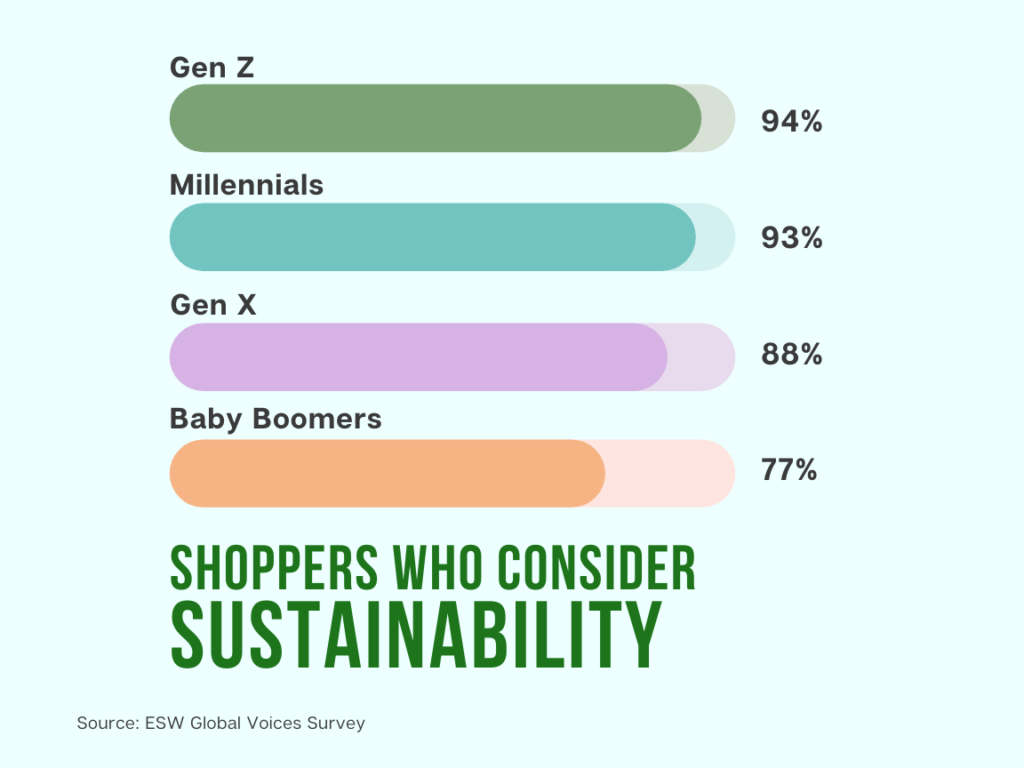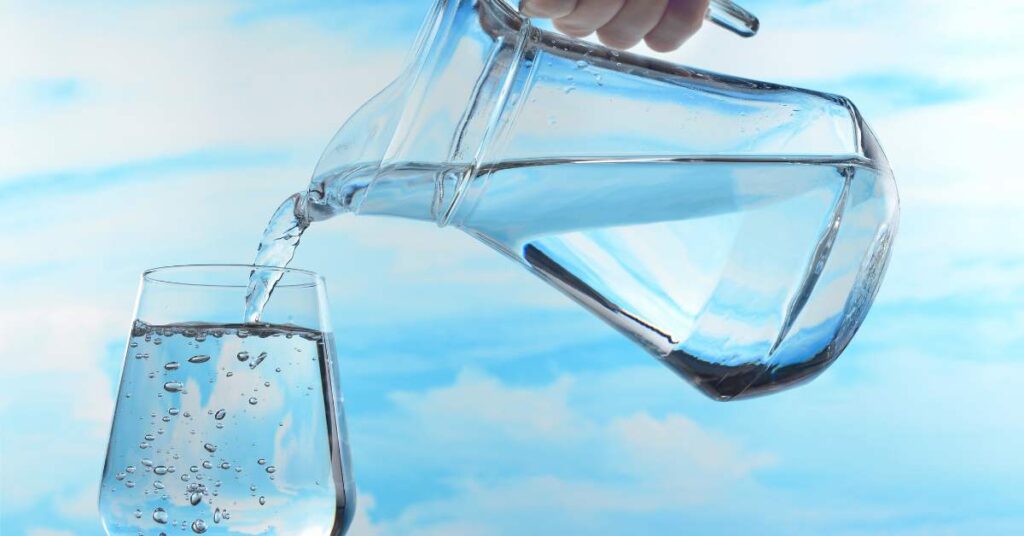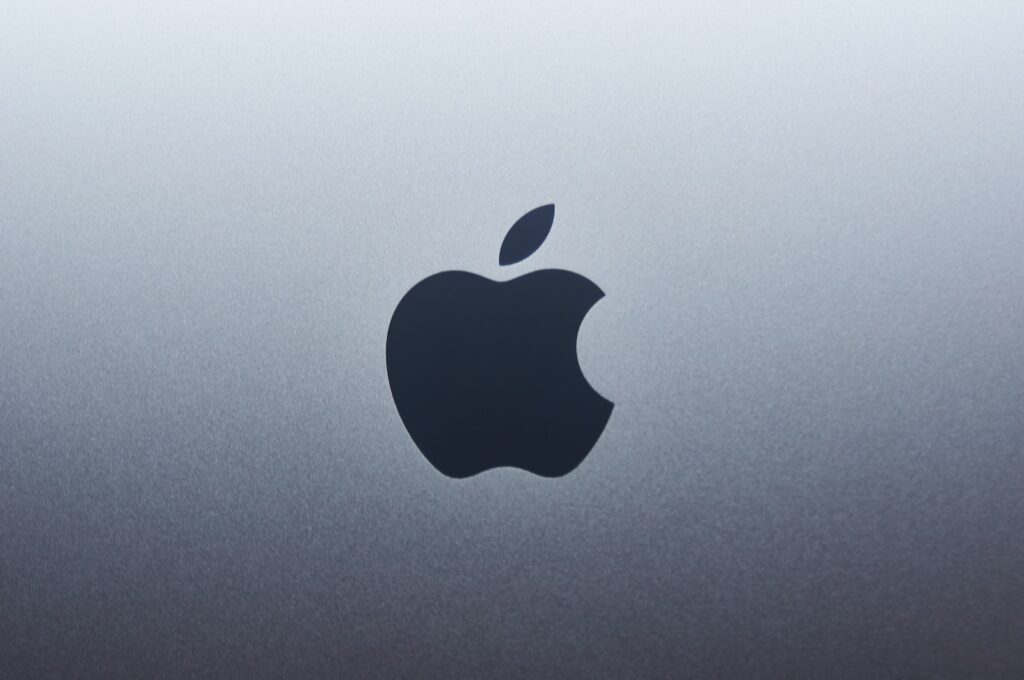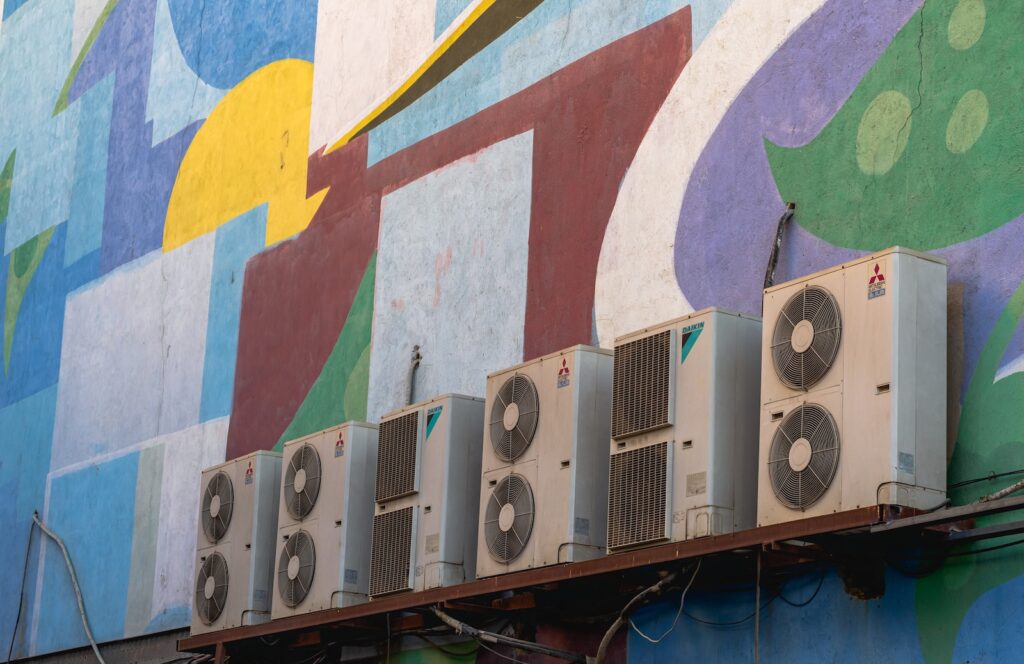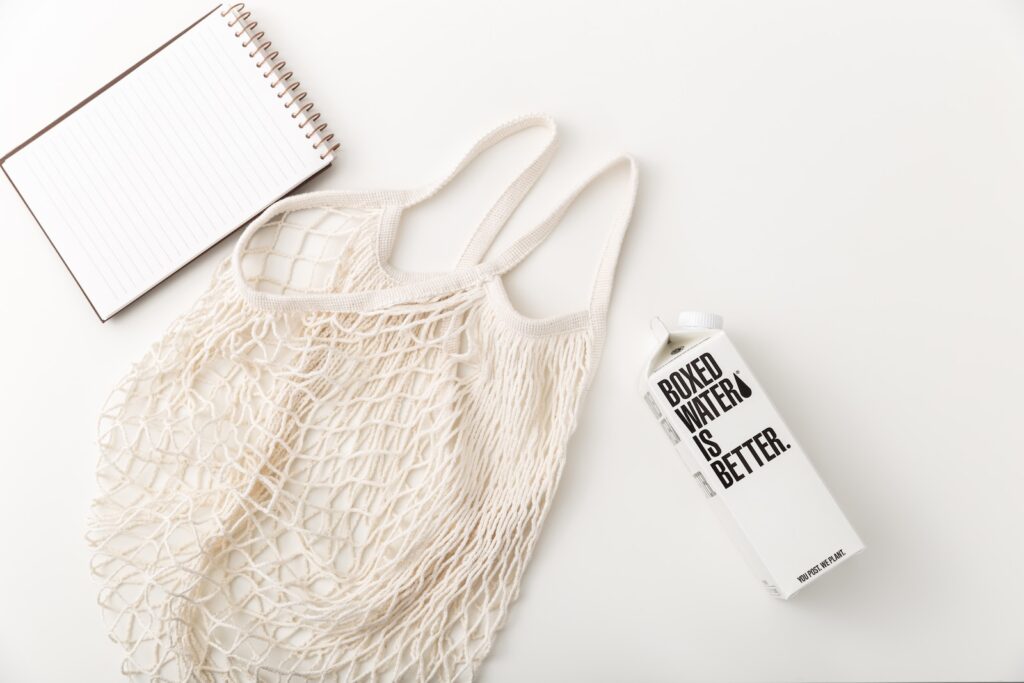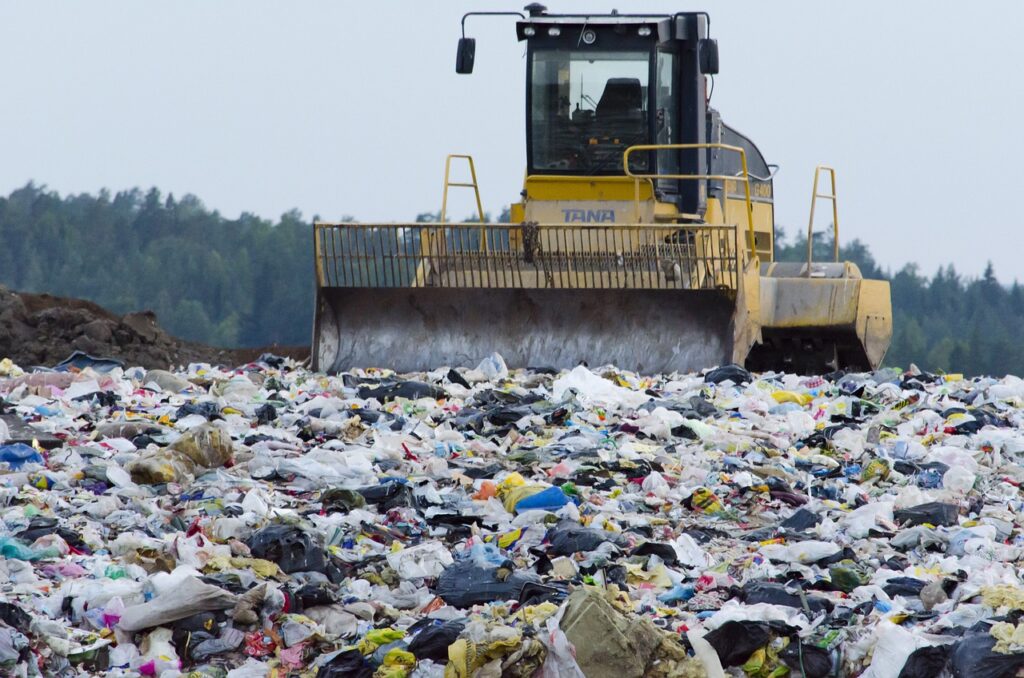Savvy, eco-conscious shoppers are increasingly aware of the impact their beauty and fashion purchases have on the environment, their health, and society at large. With pollution, waste, and unsustainable practices reaching alarming rates, there’s a dire need for change.
In this post, we unravel hard-hitting sustainability statistics that spotlight the fashion and beauty industries’ current status and the trends driving them to meet consumer demands. Whether you’re a shopper seeking to make informed choices or an eco-conscious brand looking to align with the evolving market, these facts and trends will offer clarity and direction.
From the market’s size and growth to the environmental costs of fast fashion and the innovative practices driving change, your guide to understanding and navigating this changing landscape starts here.
Sustainable Fashion and Beauty Industry Statistics
1. GLOBAL MAKET SIZE: The global personal care and beauty products market size is estimated at $518.56 billion. (Source: Grand View Research)
2. ECO-CONSCIOUS PRODUCTS: 57% of global consumers are willing to change their buying habits to help reduce negative environmental impact. (Source: National Retail Federation)
3. WASTE: Roughly 70 pounds of clothing per person are thrown away in the U.S. each year. (Source: Council for Textile Recycling)
4. GROWTH RATE: The global beauty industry and personal care market is expected to grow at a compound annual growth rate (CAGR) of 7.7% from 2023 to 2030. (Source: Grand View Research)
5. BEAUTY INDUSTRY WASTE: Annually, the beauty industry produces over 120 billion packaging units, significantly contributing to environmental waste. (Source: Zero Waste Week)
6. MICROPLASTICS: Washing synthetic clothes releases 500,000 tons of microfibers annually into the ocean. (Source: European Environment Agency)
7. GREENHOUSE EMISSIONS: The global fashion industry emits 1.7 billion tons of CO2 annually. (Source: International Labour Organization)
8. MILLENNIALS AND GEN Z: Nearly 60% of Gen Z and Millennial shoppers prefer buying sustainable beauty industry products. (Source: ESW’s Global Voices)
9. CONVENTIONAL VS. ORGANIC: The conventional beauty and personal care segment accounted for 84.8% of revenue share in 2022. However, the organic segment is anticipated to grow due to rising consumer awareness and benefits associated with organic cosmetics. (Source: Grand View Research)
10. FAST FASHION: The fashion industry produces 10% of the world’s carbon emissions. (Source: World Economic Forum)
11. WATER USAGE: The fashion industry is the second-largest consumer of the world’s water supply. (Source: World Economic Forum)
12. NATURAL SKINCARE PREFERENCE: In the U.S. 43% of Gen Z and Millennial consumers express a preference for natural skincare, surpassing 31% of the overall consumer population. (Source: Grand View Research)
13. LANDFILL: The fashion industry produces 92 million tons of waste each year. (Source: World Economic Forum)
14. WATER POLLUTION: Fashion industry production is responsible for 20% of global wastewater. (Source: Earth.Org)
15. PRODUCTION: It can take 2,700 liters of water to produce one cotton shirt. (Source: World Wildlife Fund)
16. DENIM WATER USAGE: A single pair of 501 Levi jeans consumes approximately 900 gallons of water throughout its lifecycle. (Source: Levi Strauss & Co.)
17. RENTING FASHION: The sustainable fashion rental market will be valued at $9.9 billion by 2026. (Source: GlobalData)
18. NATURAL FIBERS: Only 1% of textiles are recycled into new clothes. (Source: Ellen MacArthur Foundation)
19. CHEMICALS: Over 8,000 synthetic chemicals are used in the fashion industry. (Source: Environmental Leader)
20. ENVIRONMENTAL IMPACT: The beauty industry generates over 120 billion units of packaging every year. (Source: Zero Waste Week)
21. ANIMAL TESTING: 44 countries have banned animal-tested cosmetics. (Source: Humane Society of the United States)
22. GARMENT USAGE: From 2000 to 2014, shoppers bought 60% more garments but kept each for half as long. (Source: McKinsey & Company)
23. NON-BIODEGRADABLE CLOTHES: An estimated 60% of our clothes are made with synthetic fabrics like polyester, which can take hundreds of years to decompose. (Source: The Guardian)
24. NATURAL AND ORGANIC BEAUTY: The global natural and organic beauty market will be worth $54.5 billion by 2027. (Source: Grand View Research)
25. LEATHER TANNING: Leather tanning releases 105 million cubic feet of wastewater into the environment each year. (Source: Collective Fashion Justice)
26. E-COMMERCE RETURNS: 5 billion pounds of waste are generated through returns annually. (Source: BBC Earth)
27. POLLUTION: 20% of industrial water pollution globally is from textile dyeing and treatment. (Source: World Bank)
28. CHEMICAL CONSUMPTION: The fashion industry uses 93 billion cubic meters of water and 43 million tons of chemicals annually. (Source: World Bank)
29. BIODIVERSITY IMPACT: Cotton farming uses 24% of the word’s insecticides and 11% of pesticides while occupying only 3% of the world’s arable land. (Source: Soil Association)
30. SECOND-HAND FASHION GROWTH: The second-hand apparel market is predicted to touch $70 billion by 2027. (Source: ThredUP)
31. ETHICAL FASHION: The global ethical fashion market will reach 8 billion by 2025. (Source: Research and Markets)
32. DEFORESTATION: 300 million trees are annually cut for viscose production. (Source: Canopy)
33. ETHICAL SPENDING: The U.K.’s ethical clothing sales increased by 19.9% in 2017. (Source: Ethical Consumer)
34. CONSUMER SHIFT: Over 50% of European consumers value environmentally friendly materials when shopping for clothing. (Source: McKinsey Fashion on Climate Report)
35. PLASTIC IN THE BEAUTY INDUSTRY: In 2018, 7.9 billion units of rigid plastic were produced for beauty and personal care products in the U.S. (Source: Euromonitor International)
36. CRUELTY-FREE DEMAND: By 2030, the global cruelty-free cosmetics market is projected to exceed $14 billion. (Source: Market Research Future)
37. SINGLE-USE PLASTICS: About half a million tons of microfiber, equal to 50 billion plastic bottles, end up in the ocean annually. (Source: Ellen McArthur Foundation)
38. SYNTHETIC FIBERS: Producing synthetic fibers emits 1.35 kg CO2 per kg of fiber. (Source: Material Economics)
39. SUSTAINABLE FASHION AND BEAUTY INDUSTRY BRANDING: 66% of global Millennials will spend more on sustainable fashion and sustainable beauty brands. (Source: Nielsen)
40. SUSTAINABILITY TYPE MATTERS: Gen Z shoppers are most interested in ethical production, sustainable packaging, and less packaging overall, with carbon offsets only considered by 35% of shoppers. (Source: ESW’s Global Voices)
41. COSMETIC WASTE: Since the 1950s, more than 8.3 billion metric tons of plastic have been manufactured, with the cosmetics industry being a notable contributor. (Source: National Geographic)
42. ONLINE SHOPPING RETURNS: Online return rates can be as high as 30% compared to 10% in-store, increasing waste from packaging and shipping. (Source: Optoro)
43. ETHICAL BRANDING: 73% of Millennials and Gen Z prefer sustainable or eco-conscious brands. (Source: First Insight)
44. MEDIA IMPACT VALUE FOR SUSTAINABILITY: The MIV for sustainability grew by 54% during the first semester of 2022 compared to the first semester of 2021, accounting for $2 billion and $1.3 billion in value, respectively revealing the increasing conversation and importance of sustainability in the media. (Source: Forbes)
45. FASHION INDUSTRY RECYCLING: Less than 15% of clothes are recycled or donated. (Source: EPA)
46. MICROPLASTIC POLLUTION: Microfibres account for 91% of the microplastics in our oceans. (Source: Plymouth Marine Laboratory)
47. ECO-CONSCIOUS PACKAGING: The demand for eco-friendly cosmetic packaging is expected to rise by 5.1% annually from 2021 to 2028 to $358 million. (Source: Zion Market Research)
48. NEW BEAUTY DEMAND: The vegan beauty market will reach 28.5 billion by 2031. (Source: Allied Market Research)
49. ANIMAL PRODUCTS IN COSMETICS: Approximately 80% of countries worldwide still allow animal testing in cosmetics. (Source: Humane Society International)
50. LEATHER ALTERNATIVE GROWTH: The vegan leather fashion market is expected to hit $89.6 billion by 2025. (Source: Infinium Global Research)
51. SILK PRODUCTION: Roughly 2,500 silkworms are killed to produce a single pound of raw silk. (Source: People for the Ethical Treatment of Animals)
52. ETHICAL FOOTWEAR: The sustainable footwear market is projected to reach $13 billion by 2030. (Source: Allied Market Research)
53. BIODEGRADABLE COSMETICS: The biodegradable cosmetics market is expected to reach $10.4 Billion by 2029. (Source: Data Bridge Market Research)
54. GREEN PERFUMES: Organic fragrances, which avoid synthetic chemicals, are expected to grow to $13 billion by 2031. (Source: Transparency Market Research)
55. ORGANIC COTTON: The global organic cotton market is expected to grow to $6.7 billion by 2028. (Source: Fortune Business Insights)
56. LESS WASTE MATTERS: 51% of shoppers want to source brands focused on reducing plastic packaging. (Source: Nielsen)
57. PARABEN FREE: As of May 2022, paraben-free beauty products now make up over 60% of total beauty and personal care sales, growing at 5.3%. (Source: Nielsen)
58. NEW USERS: 33% of consumers have already tried products with reduced plastic. (Source: Nielsen)
59. WILLINGNESS TO PAY MORE: 66% of consumers will spend more on a product when it’s sustainable. (Source: ESW’s Global Voices)
60. APPAREL GROWTH: The global volume of the apparel market was forecast to continuously increase between 2023 and 2027 by 9.9 billion pieces (+5.35 percent). (Source: Statista)
61. CLEAN GROWTH: As of May 2022, products that meet the NielsenIQ Clean definition saw growth of +18% vs. 4.3% across the entire beauty and personal care category. (Source: Nielsen)
2023 Sustainable Fashion and Beauty Industry Trends:
62. RECOGNIZABLE INGREDIENTS: Clean beauty market customers are increasingly seeking ingredients they recognize and trust, such as pineapple, celery, algae, and rice, in skin care, beauty, and hair care products. (Source: Nielsen)
63. SUSTAINABLE BEAUTY PACKAGING: Brands are emphasizing eco-conscious, minimalist, and innovative packaging materials, including refillable and biodegradable options. (Source: Nielsen)
64. “FREE-FROM” CLAIMS: Products are increasingly labeled with “free-from” designations, highlighting the absence of certain allergens or chemicals with regulated accuracy. (Source: Nielsen)
65. WIDESPREAD SUSTAINABILITY ADOPTION: As consumer demand for sustainability increases, brands are aligning their practices to fulfill these expectations and remain competitive. (Source: Nielsen)
66. GOVERNMENT INTERVENTION: With a growing legislative focus on sustainability, brands are encouraged to ensure the veracity of their claims and conform to new eco-friendly standards. (Source: Nielsen)
67. RETAILER PARTICIPATION: Major retailers are prominently promoting eco-conscious, sustainable products, making it essential for brands to adapt or risk diminished market presence. (Source: Nielsen)
68. NEW PRACTICES OF SUSTAINABLE PRODUCTION: Brands are prioritizing reductions in water and energy usage during clothing production and are emphasizing low-impact dyes, water recycling, and carbon emission cuts. (Source: S.G. Analytics)
69. THE RISE OF CIRCULAR FASHION: The focus is on sustainable fashion: designing clothes for reuse, recycling, and repurposing, targeting durability and prolonged wear. (Source: S.G. Analytics)
70. REPURPOSING & UPCYCLING: Brands are innovatively employing existing fabrics and upcycled materials, such as vintage textiles, to design new sustainable fashion industry apparel. (Source: S.G. Analytics)
71. ETHICAL AND TRANSPARENT MANUFACTURING: Brands are increasing transparency regarding their supply chains and embracing ethical manufacturing practices to cater to well-informed consumer demands. (Source: S.G. Analytics)
72. GREEN PRACTICES AND REGULATION: 2023 is expected to experience a surge in green regulations in the fashion supply chain, including digital passports for goods, anti-greenwashing laws, and waste management reforms. (Source: S.G. Analytics)
73. INTEGRATION OF DATA AND A.I.: Brands are utilizing A.I. and data analytics for trend prediction and carbon footprint reduction. (Source: S.G. Analytics)
74. RENTING: AN ALTERNATIVE TO BUYING: The fashion sector is endorsing clothing rentals as an eco-conscious, sustainable fashion industry alternative, with numerous designers partnering with rental firms to offer affordable luxury experiences. (Source: S.G. Analytics)
75. VIRTUAL FITTING ROOMS: Brands are improving customer experiences with new technology, such as through virtual fitting rooms. (Source: S.G. Analytics)
The beauty and fashion industries are undergoing a transformative shift towards sustainable and eco-conscious practices. As the sustainability statistics and trends highlighted above reveal, both industries are actively responding to the urgent call for environmental responsibility and ethical considerations. Consumers, driven by a deeper understanding of the environmental and societal impacts of their purchases, are championing this change. Brands that align with these values not only cater to the demands of the present but also pave the way for a more sustainable future. As we move forward, it’s evident that the convergence of sustainability and innovation will continue to shape the beauty and fashion landscapes, ensuring that eco-consciousness is more than just a trend—it’s the future.
New at Ethical Bliss:
5 Best Pure Organic Vanilla Extract Picks
Mmm… vanilla. It’s a comforting scent like a warm hug. We bake a lot in our home,…
Best Natural Toothpaste Alternatives For Sparkling Teeth
Are you on the lookout for a more natural way to keep your smile bright and your…
A Bold Step to Improve Drinking Water Safety
The Biden-Harris Administration has taken a monumental step forward in the fight for cleaner, safer…
You Might Also Like:
Apple Steps Up Its Sustainability Game With The Eco-Friendly Apple Watch
A Bold Step to Improve Drinking Water Safety
The Biden-Harris Administration has taken a monumental step forward in the fight for cleaner, safer…
